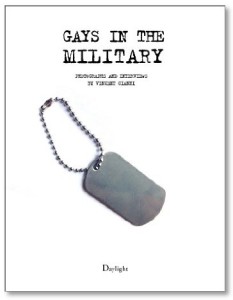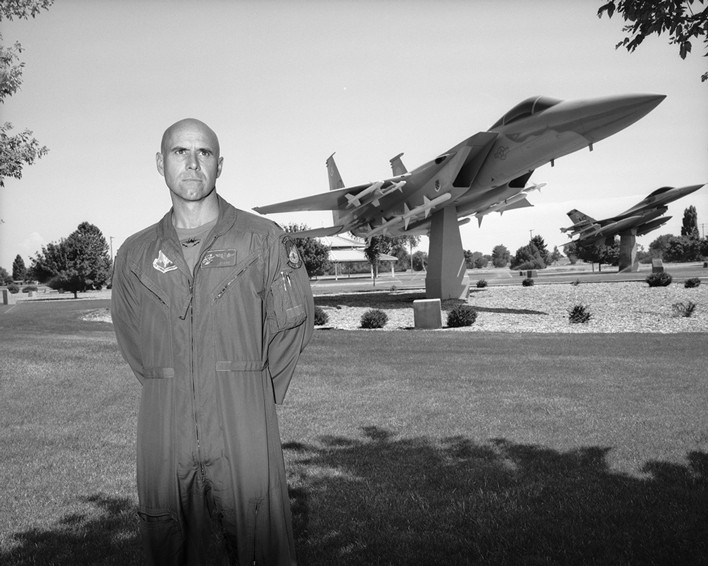 Gays in the Military: Photographs and Interviews
Gays in the Military: Photographs and Interviews
by Vincent Cianni
Daylight Books. 256 pages, $45.
BEING GAY became an explicit barrier to military service in 1950, when President Harry Truman signed the Uniform Code of Military Justice. Thirty years later, Ronald Reagan ordered the discharge of any service member who engaged in homosexual acts or stated they were homosexual (or bisexual). After failing to lift the ban, Bill Clinton signed “Don’t ask, don’t tell” (DADT) into law in 1993. Barack Obama campaigned on full repeal, which was approved in 2010 and became effective a year later.
A self-described “peacenik,” Vincent Cianni had caught a radio interview with the mother of an American soldier who had served in Iraq before being discharged for being gay. She spoke about her son with pride. The author, who’s also gay, realized that while keeping a “humane” stance against war he had been ignoring injustice in his own community, and decided to learn more about gays and lesbians who serve.
From 2009 to 2013, Cianni interviewed a hundred veterans and active-duty soldiers for this book. Cianni calls himself a “visual anthropologist.” He traveled the country, applying a simple process: listen to a person’s story and then take his or her picture. From the results, he compiled 54 short essays with photos of soldiers across a spectrum of rank, race, geography, religion, and family makeup. He used black-and-white film and shot between thirty and sixty images of each subject. The expressions and postures he captured convey a somber, often defiant dignity. In an opening essay, Alison Nordstrom, former curator at the George Eastman House photographic museum, likens Cianni’s work to that of WPA photographers Lewis Hine and Walker Evans, who practiced “truth-telling” through images. “[His] images are collaborative,” she writes, and display a “curious intensity.”

The portraits are striking, printed in soft gray tones on thick matte paper, without names. The stories, on the other hand, are set in Courier typeface on thin white sheets that recall government-issue stock. Identifying data appear at the top of each essay, while the page number of the interviewee’s photograph appears at the end, so that by turning back to that page the reader can see what a subject looks like. This roundabout process could have been made more efficient, if that were the aim, but as presented it conveys the complicated circuitry of a gay service member’s life under DADT. Just over half of the storytellers served in the Navy, Marine Corps, Coast Guard, or Merchant Marine, and the rest in the Army or Air Force—some on overseas assignments and others in stateside reserves. Two-thirds are men. Most are in their thirties, forties, or fifties.
Cianni focused on two questions: why respondents joined up, and how DADT affected their careers and lives. Their stories are often full of hardship and loss. For example, Debra Fowler, a Korean linguist in the Army during the late 1980s who earned top awards from the Defense Language Institute, was abusively outed while being investigated for top-secret security clearance, then given a dishonorable discharge. Joseph Rocha, a K-9 unit dog handler in the Navy, came out to his commanding officer after years of hazing and humiliation. Honorably discharged, he remains hobbled by post-traumatic stress from the mistreatment.
Against all odds, a few servicemen managed to push back. Victor Fehrenbach, who flew 88 combat missions in Iraq, Kuwait, and Afghanistan, was outed under DADT. At first he agreed to “stay quiet, sign a piece of paper and move on” in exchange for an honorable discharge, but later decided to reverse course and fight the decision. Anthony Loverde, an Air Force loadmaster deployed to Iraq and Afghanistan, was discharged for homosexual conduct. Although he had a civilian job offer, Loverde joined a legal challenge to force the issue of reinstatement. “I said, ‘Of course. I want to go back in the military,’” he remarks. Four years later, he was back doing the same work, at his previous rank.
Maria Zoe Dunning, a commander in the Navy and graduate of the Naval Academy, challenged the military’s ban when she was discharged after twelve years of service. She won her case using a legal strategy the Pentagon subsequently prohibited, and proudly describes how, on her retirement in 2007, she and her wife walked down the red carpet on her ship to be “piped over the side together in the first same-sex piping ceremony in U.S. Navy history.”
Most experiences did not end so happily. Martha Taylor, a supply operations officer in Canada, was expelled from the U.S. Air Force as a result of a witch-hunt in the Reagan era. She recalls: “‘I was processed out and went back to the officers’ barracks. I stood by the dumpster and took off my uniform. … I never wanted to see it again.” Still, many gay and lesbian service members speak glowingly of military service. While they resent betrayals and abuse, they nevertheless mourn the loss of work they had chosen and loved. Gays in the Military amply demonstrates how the notion of military service can captivate and inspire. The sitters in Cianni’s vivid photos display strength, and guts.
Close to 14,000 servicemembers were discharged under DADT. Gays in the Military outlines the psychological, financial, and interpersonal burdens they endured. At the same time the nation lost the resources invested in these soldiers’ training. More subtly, the armed forces suffered erosion of a core value: the expectation that soldiers will tell the truth.
Rosemary Booth is a writer and photographer living in Cambridge, Mass.





